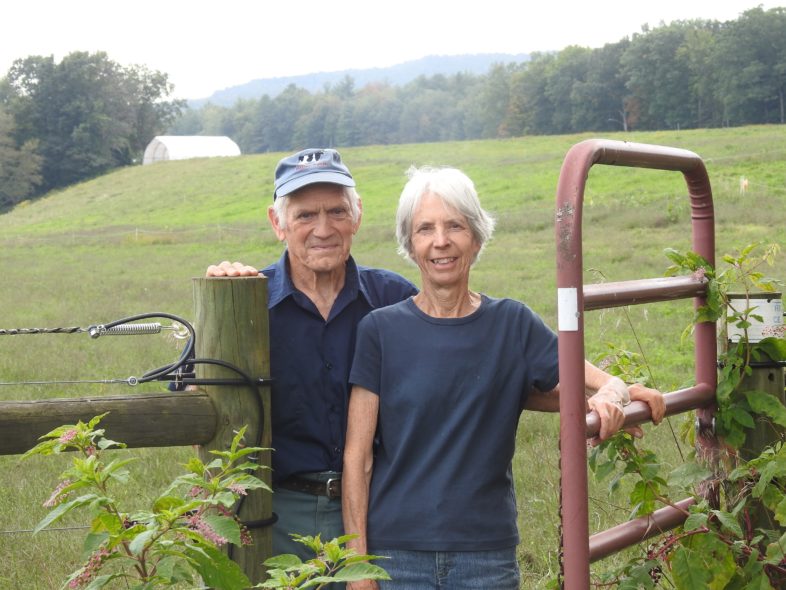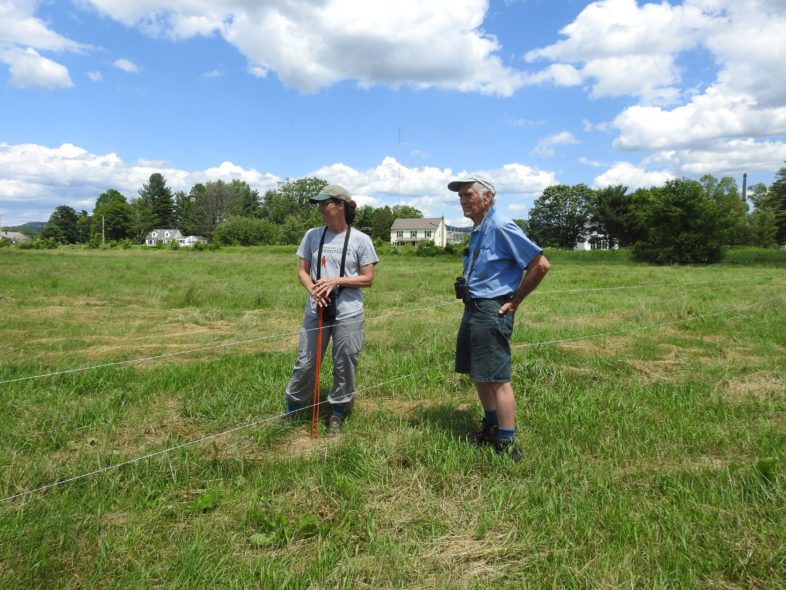
Mary and Paul Miller (C. Abbott)
By Cathryn Abbott
Once a regular summer breeder, Eastern Meadowlarks have been disappearing across much of New England. The North American Breeding Bird Survey estimates that the U.S. population has declined 80% in the past 50 years. In New England and the Mid-Atlantic, the decreases are even more staggering: 95% of the population has been lost. So when a pair of meadowlarks was spotted on Miller Farm in southern Vermont, I wasted no time. Paul and Mary Miller agreed to meet with me the next day.
For over 100 years, the Miller family has been farming 250 acres near the Connecticut River. Management is transitioning to the fourth generation, but Paul still helps with the milking each morning. Although an occasional meadowlark migrates through, it has been many years since a pair has nested on the farm.
We set out to view the meadowlarks from several vantage points. We had no luck despite repeated attempts. Finally, Mary suggested backing the farm truck up to the fence line and positioning our scope in the truck bed. Our higher perch afforded us views of the male meadowlark preening in the grasses, his bold, black ‘V’ visible across bright yellow underparts. The female proved even more difficult to observe, but over the next few days she was seen gathering nesting material while the male sang nearby. The grazing rotation of Miller Farm would put the heifers back in that paddock in nine days. We developed a plan that involved finding the nesting site and then fencing off a 100-yard radius around the nest.
Miller Farm is a busy operation, with 180 mature Holsteins producing 1600 gallons of milk each day. The Farm has weathered many formidable challenges in New England’s dairy industry, and seems to be bucking a long-term trend. Once there were 27 Vernon farms shipping milk; now there are three. The change reflects statewide (and region-wide) declines; 85% of Vermont dairy farms have gone under since 1947.
About five years ago, Miller Farm completed a transition to organic, a move that has given them some price stability. The move has brought other changes as well. Mary notes that the cows are healthier with fewer digestive ailments and lower vet bills. Paul has noticed earthworms back in the soil and a return of frogs to the farm ponds. This summer’s amphibian chorus was especially raucous. The Millers are encouraged by these changes. They see themselves as “stewards of the land,” and they “like to feel that we’re doing our part for conservation.” But they also put front and center that without financial stability, there would be no stewardship. They make the connection that the fate of the meadowlarks and other grassland birds is intimately intertwined with the productivity of our farms.

Farmer Paul Miller and VCE biologist Roz Renfrew discuss how to extend the rest period on a paddock to allow a pair of meadowlarks to nest – without undue hardship on the farm’s bottom line. (C. Abbott)
In the end, we were unable to pinpoint the exact nest location. This pair of meadowlarks lived up to the species’ reputation as maddeningly secretive. The Millers decided to adjust the grazing rotation in order to leave the entire paddock to the meadowlarks until they fledged their young. Paul set up an observation blind atop a bunker silo and twelve days later, right on schedule, the adult birds were seen carrying food for nestlings. Food deliveries continued for the next three days, but the risk of mortality is high in the days following hatching, and unfortunately this summer’s chicks did not survive.
The Millers, ever taking the long view, are already planning for next spring. If meadowlarks do turn up on the farm again, the Millers will make room for them.

any idea what happened to the chicks? predators? neighboring pesticides?
weather?
The nest was most likely depredated. There were no major weather events, and any pesticides in the general area (certainly none on this farm itself) would not be nearly toxic nor concentrated enough to outright kill chicks just from drift. We never did locate the nest itself; we didn’t want to disturb the meadowlarks by looking, or risk trampling the nest in the process. The nests are very well hidden, and meadowlarks are quick to abandon a nest if they are disturbed much. Their activities were monitored from a blind at a distance. Potential nest predators include raccoons and snakes.
thanks for your reply!
I have a field that is open all Summer. How could I provide for meadowlarks.
Thank you for your interest! Meadowlarks like big open areas, and within that they need a portion of it to have the appropriate vegetation structure for nesting, with little or no disturbance until late July. There’s no magic number on how big the open area needs to be, but I have never seen them in the Upper Valley in open habitat less than 100 acres. Given the few meadowlarks left in the Upper Valley, building it does not mean they will come. If you don’t have the fortune of already hosting a pair, you will likely be better off managing for Bobolinks, which actually does not look much different than managing for meadowlarks…and you will be more likely to see results. Bobolinks can tolerate smaller open areas (>25 acres, with a smaller portion of suitable nesting habitat), and tips, information, and other help can be found on our grassland bird management page (scroll to bottom for resources):
https://vtecostudies.org/projects/grasslands/upper-valley-grassland-bird-initiative/
If you don’t already host Bobolinks, there is no guarantee. There is contact information if you have more questions, and knowing where you are and the layout of the landscape around you would help us assess how likely it is that you could host grassland birds.
I hope you find this helpful!
Rosalind